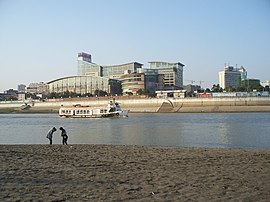| Han River | |
|---|---|
 The Han River in Wuhan | |
 Watershed of the Han River | |
| Location | |
| Country | China |
| Region | Shaanxi, Hubei |
| Cities | Hanzhong, Ankang, Shiyan, Xiangyang, Xiantao, Wuhan |
| Physical characteristics | |
| Source | Near Hanzhong |
| • location | Qin Mountains, Shaanxi |
| • coordinates | 33°08′32″N 106°49′42″E / 33.14222°N 106.82833°E |
| • elevation | 580 m (1,900 ft) |
| Mouth | Yangtze |
• location | Wuhan, Hubei |
• coordinates | 30°33′52″N 114°17′30″E / 30.56444°N 114.29167°E |
• elevation | 75 m (246 ft) |
| Length | 1,532 km (952 mi), northwest–southeast |
| Basin size | 174,300 km2 (67,300 sq mi) |
| Discharge | |
| • average | 1,632 m3/s (57,600 cu ft/s) |
| • maximum | 33,500 m3/s (1,180,000 cu ft/s) |
| Basin features | |
| River system | Yangtze basin |
| Tributaries | |
| • left | Xun, Dan, Bai River (China), Fushui River |
| • right | Du, Chi, Nan, Muma |
| Han River | |||||||||
|---|---|---|---|---|---|---|---|---|---|
| Traditional Chinese | 漢江 | ||||||||
| Simplified Chinese | 汉江 | ||||||||
| Hanyu Pinyin | Hànjiāng | ||||||||
| |||||||||
| Alternative Chinese name | |||||||||
| Traditional Chinese | 漢水 | ||||||||
| Simplified Chinese | 汉水 | ||||||||
| Hanyu Pinyin | Hànshuǐ | ||||||||
| |||||||||
The Han River, also known by its Chinese names Hanshui and Hanjiang, is a major river in Central China. A left tributary of the Yangtze, the longest river in Asia, it has a length of 1,532 km (952 mi) and is the longest tributary of the Yangtze system.
The river gave its name to the ancient Chinese Han dynasty, which marked one of ancient China's first golden ages and through it, to the Han Chinese, the dominant ethnic group in modern China and the most populous ethnic group in the world.[1] It is also the namesake of the city of Hanzhong on its upper course.
- ^ Liu, Xingwu (2004). "Han". In Ember, Carol R.; Ember, Melvin (eds.). Encyclopedia of Medical Anthropology. Springer US. pp. 703–17. doi:10.1007/0-387-29905-X_73. ISBN 978-0-306-47754-6.
The name 'Han' was derived from the Han River, an upper tributary of the Yangtze River. It was further strengthened by the famous Han Empire (206 BC–220 AD) which lasted for several hundred years when the people began active interactions with the outside world.